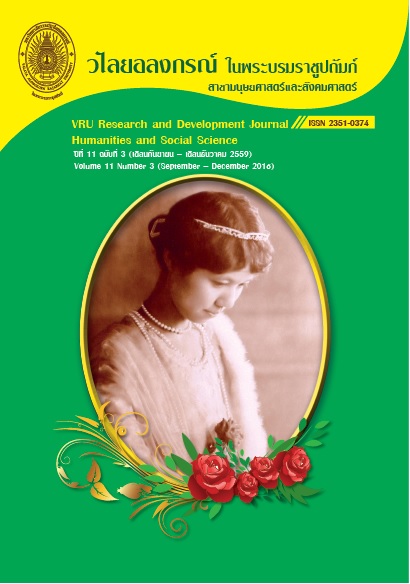การพัฒนากลยุทธ์การจัดการศึกษาเพื่อป้องกันปัญหาทะเลาะวิวาท ของนักเรียนอาชีวศึกษาจังหวัดสมุทรปราการ
Main Article Content
Abstract
การวิจัยครั้งนี้มีวัตถุประสงค์เพื่อ 1. ศึกษาสภาพการจัดการศึกษาเพื่อป้องกันปัญหาทะเลาะวิวาทของนักเรียนอาชีวศึกษาจังหวัดสมุทรปราการ 2. เพื่อพัฒนากลยุทธ์การจัดการศึกษาเพื่อป้องกันปัญหาทะเลาะวิวาทของนักเรียนอาชีวศึกษาจังหวัดสมุทรปราการ ในการศึกษาครั้งนี้ ผู้วิจัยใช้วิธีวิจัยแบบผสมผสาน ระหว่างวิจัยเชิงปริมาณและการวิจัยเชิงคุณภาพ กลุ่มตัวอย่างสำหรับการวิจัยเชิงปริมาณประกอบด้วย ก) ครูที่ทำหน้าที่เกี่ยวข้องโดยตรงกับปัญหาทะเลาะวิวาทของนักเรียน จำนวน 32 คน ได้มาด้วยการสุ่มแบบเจาะจง ข) เจ้าของสถานประกอบการ และผู้บริหารองค์กรปกครองส่วนท้องถิ่นจำนวน 101 คน ได้มาโดยการสุ่มกลุ่มตัวอย่างโดยใช้ตารางเครจซี่และมอร์แกน ค) ผู้ที่กำลังศึกษาอยู่ในระดับชั้น ปวช. และปวส. ชั้นปีสุดท้าย จำนวน 699 คน ได้มาโดยการสุ่มกลุ่มตัวอย่างโดยใช้ตารางเครจซี่และมอร์แกน เครื่องมือที่ใช้ในการเก็บรวบรวมข้อมูล ได้แก่ แบบสอบถาม สถิติที่ใช้ในการวิเคราะห์ข้อมูลได้แก่ ค่าร้อยละ ค่าเฉลี่ย และค่าเบี่ยงเบนมาตรฐาน สำหรับกลุ่มตัวอย่างที่ได้จากการวิจัยเชิงคุณภาพประกอบด้วย ผู้บริหารสถานศึกษา จำนวน 17 คน ได้มาโดยการสุ่มแบบเจาะจง เครื่องมือที่ใช้ในการเก็บรวบรวมข้อมูล ได้แก่ การวิเคราะห์เอกสารสาร และแบบสัมภาษณ์กึ่งโครงสร้าง ผู้วิจัยนำข้อมูลที่เก็บรวบรวมมาวิเคราะห์ด้วยการวิเคราะห์เนื้อหา หลังจากนั้นผู้วิจัยนำผลที่ได้ไปทำการวิเคราะห์ SWOT และ TOWS Matrix เพื่อการวางแผนกลยุทธ์ และดำเนินการประเมินความเหมาะสมและความเป็นไปได้ของ กลยุทธ์โดยใช้เทคนิคเดลฟาย
ผลการวิจัยพบว่า
1. สภาพการจัดการศึกษาเพื่อป้องกันปัญหาทะเลาะวิวาทของนักเรียนอาชีวศึกษา จังหวัดสมุทรปราการ คือ สภาพแวดล้อมของสถานศึกษาอยู่ในสภาพที่ไม่น่าพึงพอใจ เนื่องจากไม่สะอาดและไม่เป็นระเบียบเรียบร้อย ยิ่งไปกว่านั้น หลักสูตรที่ใช้อยู่ในปัจจุบัน ทั้งระดับชั้น ปวช. และปวส. ไม่ยืดหยุ่นและเหมาะสมกับสถานการณ์ปัจจุบัน นอกจากนี้ สถานศึกษายังไม่ได้มีการกำหนดวัตถุประสงค์ที่ชัดเจนสำหรับการจัดกิจกรรมส่งเสริมคุณธรรมจริยธรรมที่มุ่งป้องกันการทะเลาะวิวาทของนักเรียนในสถานศึกษา นอกจากปัญหาที่กล่าวมาแล้ว ปัญหาความยุ่งยากทางด้านการเงินและงบประมาณยังก่อให้เกิดปัญหา ทั้งต่อสถานศึกษา และผู้ปกครองนักเรียน นอกจากนี้ สถานศึกษายังไม่มีการศึกษาวิจัยอย่างจริงจังในเรื่องปัญหาการทะเลาะวิวาทของนักเรียน รวมทั้งไม่มีความร่วมมือกันอย่างแข็งขันและต่อเนื่องระหว่างสถานศึกษาและชุมชนเพื่อมุ่งแก้ปัญหาดังกล่าว
2.ความพยายามที่จะพัฒนากลยุทธ์เพื่อป้องกันปัญหาทะเลาะวิวาทของนักเรียนอาชีวศึกษาจังหวัดสมุทรปราการ ก่อให้เกิด 5 กลยุทธ์หลัก ได้แก่ 1. กลยุทธ์พัฒนาผู้เรียนและศิษย์เก่าให้มีความเข้มแข็งมีกลยุทธ์รอง 4 กลยุทธ์ 2. กลยุทธ์การจัดการศึกษาและการประสานงาน ซึ่งมีกลยุทธ์รอง 5 กลยุทธ์ 3. กลยุทธ์การจัดการเรียนรู้ หลักสูตร การพัฒนาศักยภาพ และเทคโนโลยี มีกลยุทธ์รอง 7 กลยุทธ์ 4. กลยุทธ์การบริหารงบประมาณและบริหารทรัพยากรทางการศึกษา ซึ่งมีกลยุทธ์รอง 2 กลยุทธ์ 5. กลยุทธ์การมีส่วนร่วมและเครือข่ายความร่วมมือเพื่อจัดการศึกษาร่วมกัน มีกลยุทธ์รอง 3 กลยุทธ์ ทั้งนี้มีวิธีการที่จะทำให้กลยุทธ์ประสบความสำเร็จทั้งสิ้น จำนวน 85 วิธีการ
The purposes of this study were to: 1. study the circumstances of educational management aimed at the prevention of quarrelling and fighting among students at Samutprakarn vocational colleges. 2. develop an educational management strategy aimed at the prevention of quarrelling and fighting among students at Samutprakarn vocational colleges. In this study, the researcher used mixed methodologies of quantitative research and qualitative research. The sample for the quantitative research was comprised of: a) 32 teachers directly involved with the problem, obtained by purposive sampling, b) 101 entrepreneurs and administrators of local administration organizations, obtained by using a Crejcie & Morgan Calculation Table, and c) 699 current students who had studied at the vocational certificate and higher vocational certificate levels, obtained by using a Crejcie & Morgan Calculation Table. The tool used for data collection was a questionnaire. The statistics used for data analysis were percentage, mean, and standard deviation. On the other hand, the sample for the qualitative research was comprised of 17 administrators obtained by purposive sampling. The tools used for data collection were document analysis and semi-structured interviews. The collected data was analyzed by means of content analysis. After data analysis, the results were further analyzed by means of SWOT analysis and TOWS Matirx, for the purpose of strategy planning, and then the researcher used Delphi technique to determine the appropriateness and probability of the strategy.
The results of the study were as follows:
1.The circumstances of educational management aimed at the prevention of students quarrelling and fighting were that the environment of the vocational colleges was not satisfactory, since it lacked cleanliness and order. Moreover, the current curriculums used at the vocational certificate and higher vocational certificate levels were not modern, flexible, or congruent with the changing world. In addition, the vocational colleges had not issued clear purposes for the organization of ethics and morality promotional activities aimed at the prevention of students quarrelling and fighting. Moreover, financial and budgetary difficulties caused a number of problems for, not only the colleges, but also the students parents. Apart from that, the colleges lacked study on the current problems of students quarrelling and fighting, and there was no active collaborative participation between the colleges and communities dedicated to solving the mentioned problems.
2.The effort to develop a strategy aimed at the prevention of quarrelling and fighting among Samutprakarn vocational college students brought about 5 major component strategies, namely: 1. Students and alumni development strategy, consisting of 4 minor strategies. 2. Educational management and collaboration strategy, consisting of 5 minor strategies. 3. Learning and curriculum management, capability, and technology development strategy, consisting of 7 minor strategies, 4. Strategy for budgetary and educational resources management, consisting of 2 minor strategies, and 5. Strategy for participation and collaboration connections, aimed at mutual educational management, consisting of 3 strategies. These mentioned strategies include 85 methods to be used for bringing about the success of the overall strategy.
Article Details
ลิขสิทธิ์บทความวิจัยที่ได้รับการตีพิมพ์เผยแพร่ในวารสารมนุษยศาสตร์และสังคมศาสตร์ วไลยอลงกรณ์ ในพระบรมราชูปถัมภ์ ถือเป็นกรรมสิทธิ์ของคณะมนุษยศาสตร์และสังคมศาสตร์ มหาวิทยาลัยราชภัฏวไลยอลงกรณ์ ในพระบรมราชูปถัมภ์ ห้ามนำข้อความทั้งหมดหรือบางส่วนไปพิมพ์ซ้ำ เว้นแต่จะได้รับอนุญาตจากมหาวิทยาลัยเป็นลายลักษณ์อักษร
ความรับผิดชอบ เนื้อหาต้นฉบับที่ปรากฏในวารสารมนุษยศาสตร์และสังคมศาสตร์ วไลยอลงกรณ์ ในพระบรมราชูปถัมภ์ เป็นความรับผิดชอบของผู้นิพนธ์บทความหรือผู้เขียนเอง ทั้งนี้ไม่รวมความผิดพลาดอันเกิดจากเทคนิคการพิมพ์
References
กองวิจัยสำนักงานตำรวจแห่งชาติ. (2555). มาตรการของเจ้าหน้าที่ตำรวจและมาตรการทางสังคมกับการแก้ไขปัญหาทะเลาะวิวาทของนักเรียน/นักศึกษาต่างสถาบัน. กรุงเทพฯ: สำนักงานตำรวจแห่งชาติ.
เกียรติภูมิ วงศ์จิตและคนอื่นๆ. (2552). การพัฒนาแบบประเมินความเสี่ยงต่อพฤติกรรรุนแรงในนักเรียนอาชีวศึกษา. โรงพยาบาลศรีธัญญา กรมสุขภาพจิต กระทรวงสาธารณสุข.
นิเวศน์ วงศ์สุวรรณ. (2553). การสร้างและพัฒนารูปแบบการลดพฤติกรรมความรุนแรงของวัยรุ่น ตามแนวทางพระพุทธศาสนา. คณะครุศาสตร์ มหาวิทยาลัยมหาจุฬาลงกรณราชวิทยาลัย.
บรรเลง ศรนิล. (2552, กันยายน-ธันวาคม). การศึกษาแนวทางการผลิตกำลังคนด้านอาชีวศึกษาและเทคโนโลยีตามความต้องการของประเทศ: กรณีศึกษาประเภทอุตสาหกรรม. วารสารวิชาการพระจอมเกล้าพระนครเหนือ, 19 (3), 415-424.
สุวิทย์ เมษินทรีย์. (2557). รายงานการวิจัยแนวทางการพัฒนาการศึกษาไทยกับการเตรียมความพร้อมสู่ศตวรรษที่ 21. กรุงเทพฯ: สำนักงานเลขาธิการสภาการศึกษา กระทรวงศึกษาธิการ.
สำนักงานเลขาธิการสภาการศึกษา . (2557). แนวทางการพัฒนาการศึกษาไทยกับการเตรียมความพร้อมสู่ศตวรรษที่ 2. กรุงเทพฯ: พริกหวานกราฟิก.
อัมพร เรืองศรี. (2554). การพัฒนารูปแบบการพัฒนาคุณลักษณะของนักเรียนตามแนวปรัชญาเศรษฐกิจพอเพียง. ปริญญานิพนธ์ปรัชญาดุษฎีบัณฑิต สาขาวิชาการศึกษาและการพัฒนาสังคม คณะศึกษาศาสตร์ มหาวิทยาลัยบูรพา.
อํารุง จันทวานิช และคณะ. (2553). โรงเรียนสมบูรณแบบ: วารสารวิชาการ. 6(1), 20-23.
Broom, L. and Selznick, P. (1981). Sociology: A text with Adapted Readings (7th ed. New York: Harper & Row.
Dalton, J., Elias, M., & Wandersman, A. (2001). Community Psychology: Linking Individuals and Communities. Belmont,CA: Wadsworth/Thompson Learning
Fred C. Lunenburg & Ornstein, (2012). Professor Department of Educational Leadership & Counseling (6th Edition). Texas: Sam Houston State University.
Frued, A. (1929). On the theory of analysis of children, Psychoanalysis, 10 (2). 29-38
Krejcie, R.V. and Morgan, D.W. (1970). Determining Sample Size for Research Activities. Educationnal and Psychological Measurement, 30 (3), pp. 607-610


